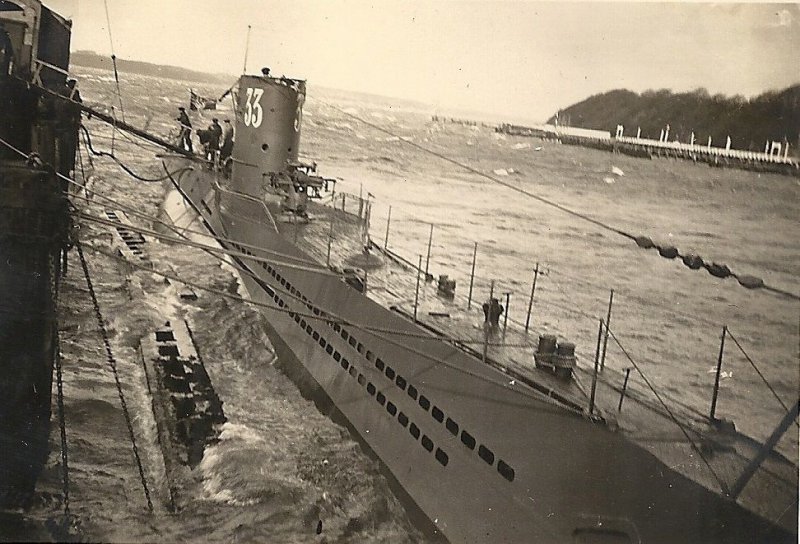On the 11th of June 1936, German U-boat U-33 was commissioned in Kiel. A type VII-A, U-33 weighed 745 tonnes and was armed with 5 torpedo tubes (1 fore and 1 aft), one deck gun and one AA gun with the ability to lay mines from the torpedo tubes.
Prior to the outbreak of World War II U-33 took part in Operation Ursula: the German submarine operation that supported Franco’s nationalist naval forces in the Spanish Civil War.
Once World War II started, U-33 conducted 3 major sorties into the seas around Britain which resulted in the sinking of 10 ships and, ultimately, the sinking of U-33 itself.

Under the command of Kapitänleutenant Hans Wilhelm von Dresky, U-33 conducted operations to the west of Ireland and in the Bay of Biscay throughout September 1939.
During this mission U-33 sank 3 British steamships (Olivegrove, Arkelside & Caldew) and was attacked twice by British aircraft however it evaded damage through emergency diving.
The second mission of U-33 commenced on the 29th of October 1939. This time, the objective was to lay a mine barrier in the Bristol Channel. On the 9th of November U-33 finished laying 12 mines and headed north to begin operations between Shetland and North Foreland. On the 20th & 21st of November, U-33 successfully sank 5 British fishing ships with artillery fire. On the 23rd, U-33 encountered the captured German freighter Borkum and engaged it causing severe damage with artillery fire (and missing with 3 torpedo’s) before disengaging.
Borkum didn’t sink, instead it reached shore where it was declared to be beyond repair. The mines laid in the Bristol Channel caused the loss of a freighter and an oil tanker and U-33 returned to Wilhelmshaven on the 26th of November for maintenance and a major refit.
The final mission of U-33 came at the order of Adolf Hitler himself. U-33 was to undertake another mine laying mission, this time at the entrance to the Clyde, one of the most important British seaways. The 42 men of U-33 set off on the 5th of February 1940 and immediately encountered galeforce winds and stormy seas. Their arrival in the outer Clyde on the evening of the 11th must have been a welcome relief from rolling in the Atlantic Ocean.
At the same time the Royal Navy minesweeper and anti-submarine vessel HMS Gleaner was conducting operations in the area, captained by Lieutenant-Commander Hugh Price. Gleaner was operating in a triangular area, from the southern tip of Arran up to Pladda lighthouse and out over the Firth of Clyde. At 02:50am, Gleaner made contact with U-33, when the hydrophone officer heard what sounded like a diesel engine, and the 80 man crew swiftly had the 4-inch guns and depth charge launchers manned and ready for action. What followed was a tense cat-and-mouse game in the darkness.
Almost as soon as they had established contact with U-33 they lost it. What followed was a search to re-establish contact with the u-boat. Using hydrophone and sonar, Gleaner searched for 20 minutes without sign the crew was losing hope when a shout from the sonar operator went up: they had located U-33. The searchlight was activated and spotted the spray from the periscope of U-33. Gleaner raced towards the location at full speed.
Dresky on U-33 ordered the lowering of the periscope and the u-boat stopped engines and lay motionless above the seabed, silently hoping to avoid further detection. The silence was broken by the explosions of the first depth charges being dropped by Gleaner and damage to the starboard side caused the lights to go out, instruments to be damaged and leaks to develop. Kapitänleutnant Fritz Schilling recommended to Dresky that they should surface but he refused, deciding instead to remain submerged and still in the hope the British ship would move on.
This decision was fateful. While Gleaner had lost contact with U-33 due to the explosions from the depth charges, they didn’t stop dropping depth charges over the area. Gleaner dropped more charges, gaining and losing sonar contact with the u-boat over the next 2 hours. After the 3rd batch of depth charges were dropped, U-33 surfaced at 05:22am.
Gleaner fired 5 volleys from the 4-inch gun and was prepared for ramming when it was spotted that the crew of U-33 had climbed onto the deck with arms raised in surrender.
As Gleaner approached, U-33 was rocked by an internal explosion and the crew dove into the icy water. Dresky ordered an explosive charge to be placed in order to destroy the classified equipment on board and the wheels of the enigma machine on board were distributed to some of the crew, with orders to drop them in the sea once in the water.
Crucially, the wheels were not all dropped in the water and three wheels were found on one of the crewmen, which were subsequently sent to Bletchley Park and helped to crack the German codes.
Due to the harsh conditions, distance between the two vessels and time taken for Gleaner to lower her life boats, only 4 officers and 13 sailors from the u-boat survived from the 42 man crew. Dresky died in the sinking, with the survivors handed over to the local police before being transported to a prisoner of war camp. The bodies of the dead were given a ceremonial funeral with full military honours at Greenock Cemetery. The bodies were later exhumed in 1962 and transferred to the new German war cemetery at Cannock Chase in England.
Today, the wreckage of U-33 still lies 5 miles south of Pladda, with the bow pointing east towards the Ayrshire coast.
Further Reading
Cannock Chase War Cemetery at CWGC.com
The History of German War Graves in the UK at CWGC.com